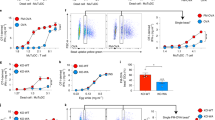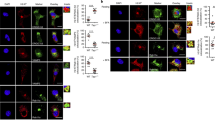Abstract
The ability to process microbial antigens and present them at the surface of cells is an important aspect of our innate ability to clear infections. It is generally accepted that antigens in the cytoplasm are loaded in the endoplasmic reticulum and presented at the cell surface on major histocompatibility complex (MHC) class I molecules, whereas peptides present in endo/phagocytic compartments are presented on MHC class II molecules1,2. Despite the apparent segregation of the class I and class II pathways, antigens from intracellular pathogens including mycobacteria, Escherichia coli, Salmonella typhimurium, Brucella abortus and Leishmania, have been shown to elicit an MHC class-I-dependent CD8+ T-cell response3,4,5,6,7, a process referred to as cross-presentation2. The cellular mechanisms allowing the cross-presentation pathway are poorly understood. Here we show that phagosomes display the elements and properties needed to be self-sufficient for the cross-presentation of exogenous antigens, a newly ascribed function linked to phagocytosis mediated by the endoplasmic reticulum.
This is a preview of subscription content, access via your institution
Access options
Subscribe to this journal
Receive 51 print issues and online access
$199.00 per year
only $3.90 per issue
Buy this article
- Purchase on Springer Link
- Instant access to full article PDF
Prices may be subject to local taxes which are calculated during checkout




Similar content being viewed by others
References
Watts, C. & Amigorena, S. Phagocytosis and antigen presentation. Semin. Immunol. 13, 373–379 (2001)
Heath, W. R. & Carbone, F. R. Cross-presentation in viral immunity and self-tolerance. Nature Rev. Immunol. 1, 126–134 (2001)
Pfeifer, J. D. et al. Phagocytic processing of bacterial antigens for class I MHC presentation to T cells. Nature 361, 359–362 (1993)
Oliveira, S. C. & Splitter, G. A. CD8 + type 1 CD44hi CD45 RBlo T lymphocytes control intracellular Brucella abortus infection as demonstrated in major histocompatibility complex class I- and class II-deficient mice. Eur. J. Immunol. 25, 2551–2557 (1995)
Turner, J. & Dockrell, H. M. Stimulation of human peripheral blood mononuclear cells with live Mycobacterium bovis BCG activates cytolytic CD8 + T cells in vitro. Immunology 87, 339–342 (1996)
Canaday, D. H. et al. Activation of human CD8 + alpha beta TCR + cells by Mycobacterium tuberculosis via an alternate class I MHC antigen-processing pathway. J. Immunol. 162, 372–379 (1999)
Belkaid, Y. et al. CD8 + T cells are required for primary immunity in C57BL/6 mice following low-dose, intradermal challenge with Leishmania major. J. Immunol. 168, 3992–4000 (2002)
Kovacsovics-Bankowski, M. & Rock, K. L. A phagosome-to-cytosol pathway for exogenous antigens presented on MHC class I molecules. Science 267, 243–246 (1995)
Rodriguez, A., Regnault, A., Kleijmeer, M., Ricciardi-Castagnoli, P. & Amigorena, S. Selective transport of internalized antigens to the cytosol for MHC class I presentation in dendritic cells. Nature Cell Biol. 1, 362–368 (1999)
Gagnon, E. et al. Endoplasmic reticulum-mediated phagocytosis is a mechanism of entry into macrophages. Cell 110, 119–131 (2002)
Wiertz, E. J. et al. Sec61-mediated transfer of a membrane protein from the endoplasmic reticulum to the proteasome for destruction. Nature 384, 432–438 (1996)
Tirosh, B., Furman, M. H., Tortorella, D. & Ploegh, H. L. Protein unfolding is not a prerequisite for ER-to-cytosol dislocation. J. Biol. Chem. 278, 6664–6672 (2003)
Schmitz, A., Herrgen, H., Winkeler, A. & Herzog, V. Cholera toxin is exported from microsomes by the Sec61p complex. J. Cell Biol. 148, 1203–1212 (2000)
Rodriguez, A., Regnault, A., Kleijmeer, M., Ricciardi-Castagnoli, P. & Amigorena, S. Selective transport of internalized antigens to the cytosol for MHC class I presentation in dendritic cells. Nature Cell Biol. 1, 362–368 (1999)
Hazes, B. & Read, R. J. Accumulating evidence suggests that several AB-toxins subvert the endoplasmic reticulum-associated protein degradation pathway to enter target cells. Biochemistry 36, 11051–11054 (1997)
Rivett, A. J., Palmer, A. & Knecht, E. Electron microscopic localization of the multicatalytic proteinase complex in rat liver and in cultured cells. J. Histochem. Cytochem. 40, 1165–1172 (1992)
Brooks, P., Murray, R. Z., Mason, G. G., Hendil, K. B. & Rivett, A. J. Association of immunoproteasomes with the endoplasmic reticulum. Biochem. J. 352, 611–615 (2000)
Dermine, J. F. et al. Flotillin-1-enriched lipid raft domains accumulate on maturing phagosomes. J. Biol. Chem. 276, 18507–18512 (2001)
Schagger, H., Cramer, W. A. & von Jagow, G. Analysis of molecular masses and oligomeric states of protein complexes by blue native electrophoresis and isolation of membrane protein complexes by two-dimensional native electrophoresis. Anal. Biochem. 217, 220–230 (1994)
Porgador, A., Yewdell, J. W., Deng, Y., Bennink, J. R. & Germain, R. N. Localization, quantitation, and in situ detection of specific peptide-MHC class I complexes using a monoclonal antibody. Immunity 6, 715–726 (1997)
Princiotta, M. F. et al. Quantitating protein synthesis, degradation, and endogenous antigen processing. Immunity 18, 343–354 (2003)
MacAry, P. A. et al. Mobilization of MHC class I molecules from late endosomes to the cell surface following activation of CD34-derived human Langerhans cells. Proc. Natl Acad. Sci. USA 98, 3982–3987 (2001)
Ramachandra, L., Song, R. & Harding, C. V. Phagosomes are fully competent antigen-processing organelles that mediate the formation of peptide:class II MHC complexes. J. Immunol. 162, 3263–3272 (1999)
Garin, J. et al. The phagosome proteome: insight into phagosome functions. J. Cell Biol. 152, 165–180 (2001)
Muno, D., Kominami, E. & Mizuochi, T. Generation of both MHC class I- and class II-restricted antigenic peptides from exogenously added ovalbumin in murine phagosomes. FEBS Lett. 478, 178–182 (2000)
Lennon-Dumenil, A. M. et al. Analysis of protease activity in live antigen-presenting cells shows regulation of the phagosomal proteolytic contents during dendritic cell activation. J. Exp. Med. 196, 529–540 (2002)
Tsai, B., Ye, Y. & Rapoport, T. A. Retro-translocation of proteins from the endoplasmic reticulum into the cytosol. Nature Rev. Mol. Cell Biol. 3, 246–255 (2002)
Mahnke, K. et al. The dendritic cell receptor for endocytosis, DEC-205, can recycle and enhance antigen presentation via major histocompatibility complex class II-positive lysosomal compartments. J. Cell Biol. 151, 673–684 (2000)
Guermonprez, P. et al. ER–phagosome fusion defines an MHC class I cross-presentation compartment in dendritic cells. Nature 425, 397–402 (2003)
Kovacsovics-Bankowski, M., Clark, K., Benacerraf, B. & Rock, K. L. Efficient major histocompatibility complex class I presentation of exogenous antigen upon phagocytosis by macrophages. Proc. Natl Acad. Sci. USA 90, 4942–4946 (1993)
Acknowledgements
We thank C. Rondeau, S. Tessier and A. Carrier for technical assistance and G. Milon for discussions. We thank K. Rock for the BMA3.1A and BMC2 cell lines. We also thank D. Boismenu and J. Bergeron from the Montreal Proteomics Network for help with the mass spectrometry analyses of the blue native gel samples. This work was supported by the Canadian Institute for Health Research, Genome Canada/Québec (M.D.), and the NIH (D.S.).
Author information
Authors and Affiliations
Corresponding author
Ethics declarations
Competing interests
The authors declare that they have no competing financial interests.
Supplementary information
Rights and permissions
About this article
Cite this article
Houde, M., Bertholet, S., Gagnon, E. et al. Phagosomes are competent organelles for antigen cross-presentation. Nature 425, 402–406 (2003). https://doi.org/10.1038/nature01912
Received:
Accepted:
Issue Date:
DOI: https://doi.org/10.1038/nature01912
This article is cited by
-
Increased cross-presentation by dendritic cells and enhanced anti-tumour therapy using the Arp2/3 inhibitor CK666
British Journal of Cancer (2023)
-
Efferocytosis requires periphagosomal Ca2+-signaling and TRPM7-mediated electrical activity
Nature Communications (2022)
-
The receptor DNGR-1 signals for phagosomal rupture to promote cross-presentation of dead-cell-associated antigens
Nature Immunology (2021)
-
Hemocyte phagosomal proteome is dynamically shaped by cytoskeleton remodeling and interorganellar communication with endoplasmic reticulum during phagocytosis in a marine invertebrate, Crassostrea gigas
Scientific Reports (2020)
-
Transcriptomic analysis of differentially expressed genes in the oviduct of Rhacophorus omeimontis provides insights into foam nest construction
BMC Genomics (2019)
Comments
By submitting a comment you agree to abide by our Terms and Community Guidelines. If you find something abusive or that does not comply with our terms or guidelines please flag it as inappropriate.



